There's a lot of advice out there about writing better social media content. Everything from when to post to how and what to write. Problem is, those tips are meaningless when used on their own.
The key to writing great social media posts is incorporating a variety of elements. So how do you write social media content your audience actually wants to read and share?
Once you understand a few social media fundamentals, you'll have the recipe for success. Below are 7 tips to get you started!
1. Know what your audience wants (and needs)
All great content begins with detailed research. Getting inside the head of your audience will make content creation that much easier. To learn what they're looking for, head over to Facebook Audience Insights. What you're researching is what content your audience is interacting with. What is it that they like, share, and comment on every day?
This will help you form a hypothesis around their likes, needs, and wants. Rather than guessing, we're looking to data to tell the story. You can filter your audience by location, activities, and even buying decisions. This information will help you plan content ideas. Look at it as vital details to your content creation.

To get started, choose your audience as “everyone on Facebook.” This will give you a broader search than those just connected to your Page. Leave your location as-is unless you're a local business and move the Advanced section. If you have a price point (high-end or luxury buyers, for example), you can add work, education, or financial information here.

Here we'll add an interest that ties to your business keyword. (e.g. you're a bakery, you might use "cupcake"). This is going to help you filter content based on similar brand pages.Now, here's where it gets fun. ?Go to the “Page Likes” tab to see what pages your audience is interacting with.
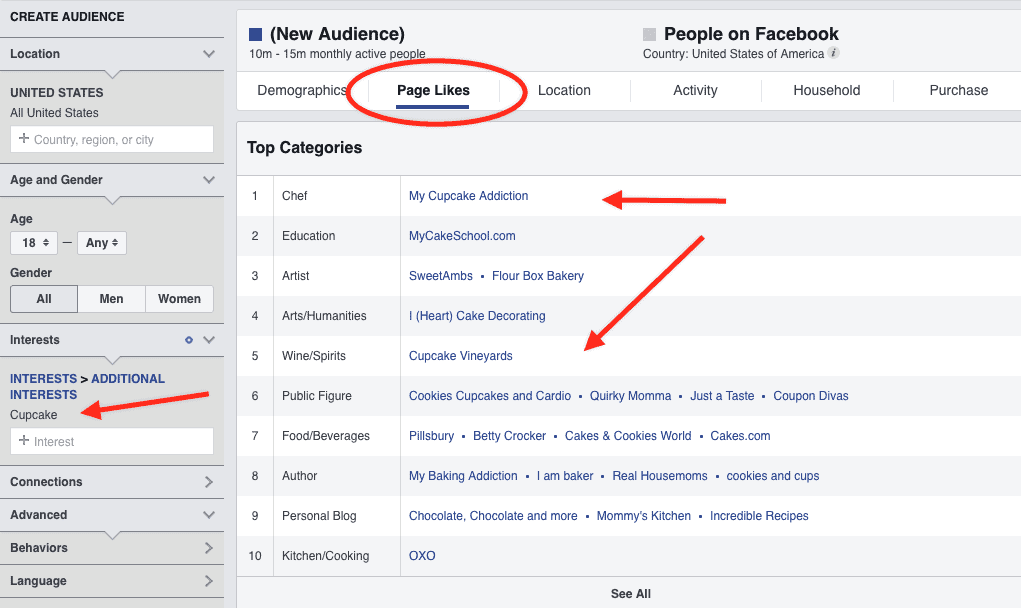
Begin to click-through each page and write down a few things as you go. You're looking to learn from high interaction pages. (10% engagement or more)
- What type of content are they sharing? (articles, images, quotes, motivational, educational)
- How much text are they using in their post descriptions? (long vs. short)
- What’s their style? (funny, serious, aloof, friendly)
- What content receives the highest amount of comments, likes, and shares?
Now take that info and consider your own content.
- Does yours have a healthy mix or are your posts all the same? (e.g. type, length, promotional vs entertaining)
- Is your content, tone, product, service, and voice easily recognizable?
- Can your audience discern who you are or what you do? If not, it's impossible to win them over.
Likewise, if you don’t know what your customers are looking for, you’ll never be able to provide it.[Tweet "Do your research, get to know your audience, then write your #socialmedia content."]
2. Write for your reader (not YOU)
Have you ever read a social media post and felt like it was written just for you? That’s what knowing your audience can do for your content. Once you've taken step one and know what they want, now it's time to write with your audience in mind.
Those two ingredients are the recipe for content gold! Because once you understand their perspective, you can communicate in their language. Not many do this better than GoPro. They've perfected the art of User Generated Content combined with a simple but targeted description.
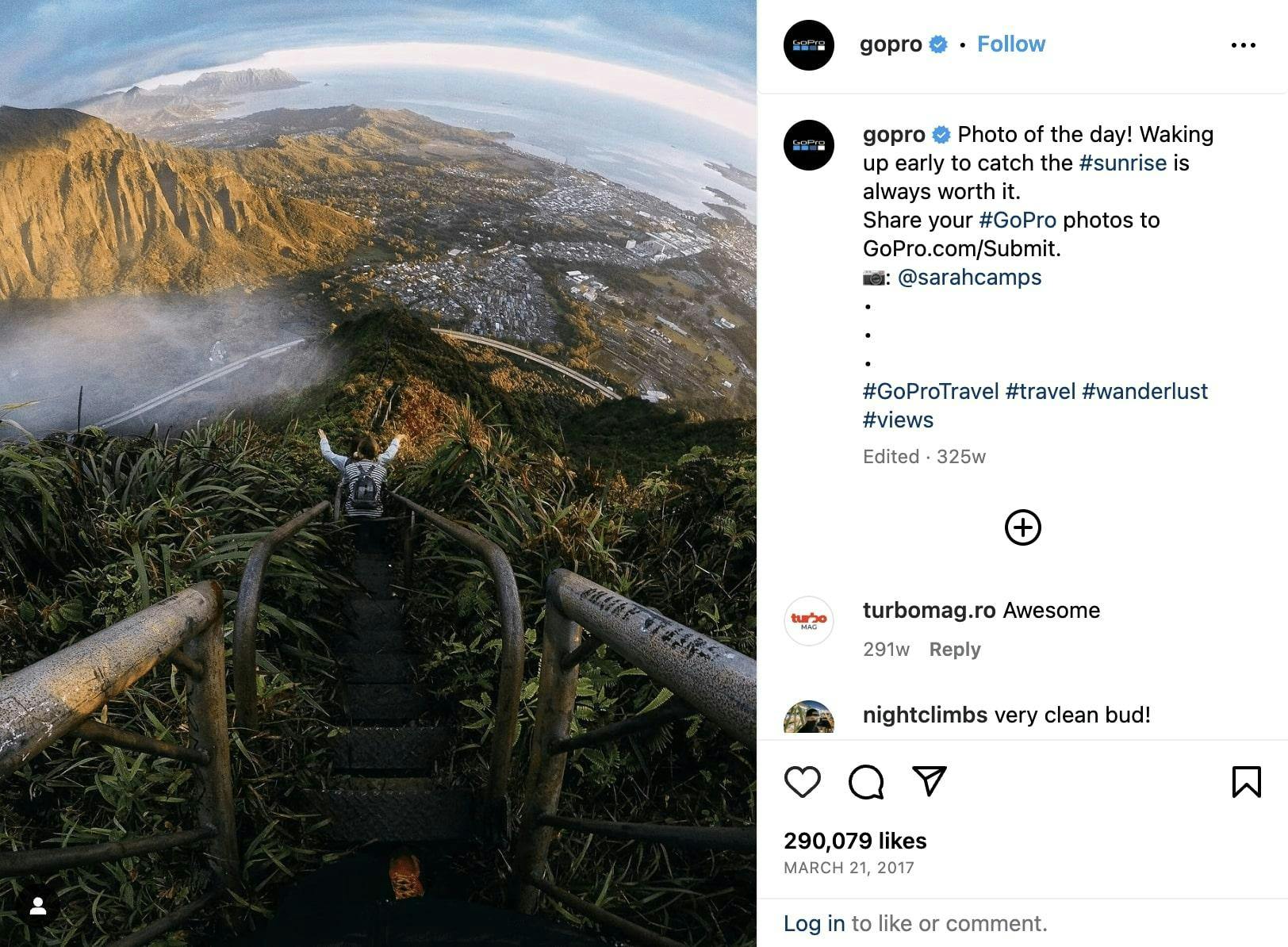
A post shared by gopro (@gopro) on Mar 21, 2017 at 9:23am PDT
There's no doubt they know their audience and what they're looking for when visiting the GoPro profile. How can you translate this to your business? Get specific and then segment your audience.
Neil Patel of QuickSprout recommends that you define your target customers by creating detailed descriptions. This is known as persona marketing. It’s a visual and descriptive representation of your ideal customer. If you haven’t gone through this exercise, I highly suggest you start here.
Getting started with personas
You can create one buyer persona or several to fit the demographics of your audience. They can be simple or complicated as long as they succeed in creating a clear picture of what motivates your customers. To do this, you’ll need to consider your customers’ behavioral drivers and their goals, as well as their mindset. For example, write down:
- Gender
- Age
- Job Description
- Skills/Responsibilities
- Income
- Size of Company
It’s also crucial to understand the concerns and hesitations that your buyers have that may prevent them from choosing your product or service.
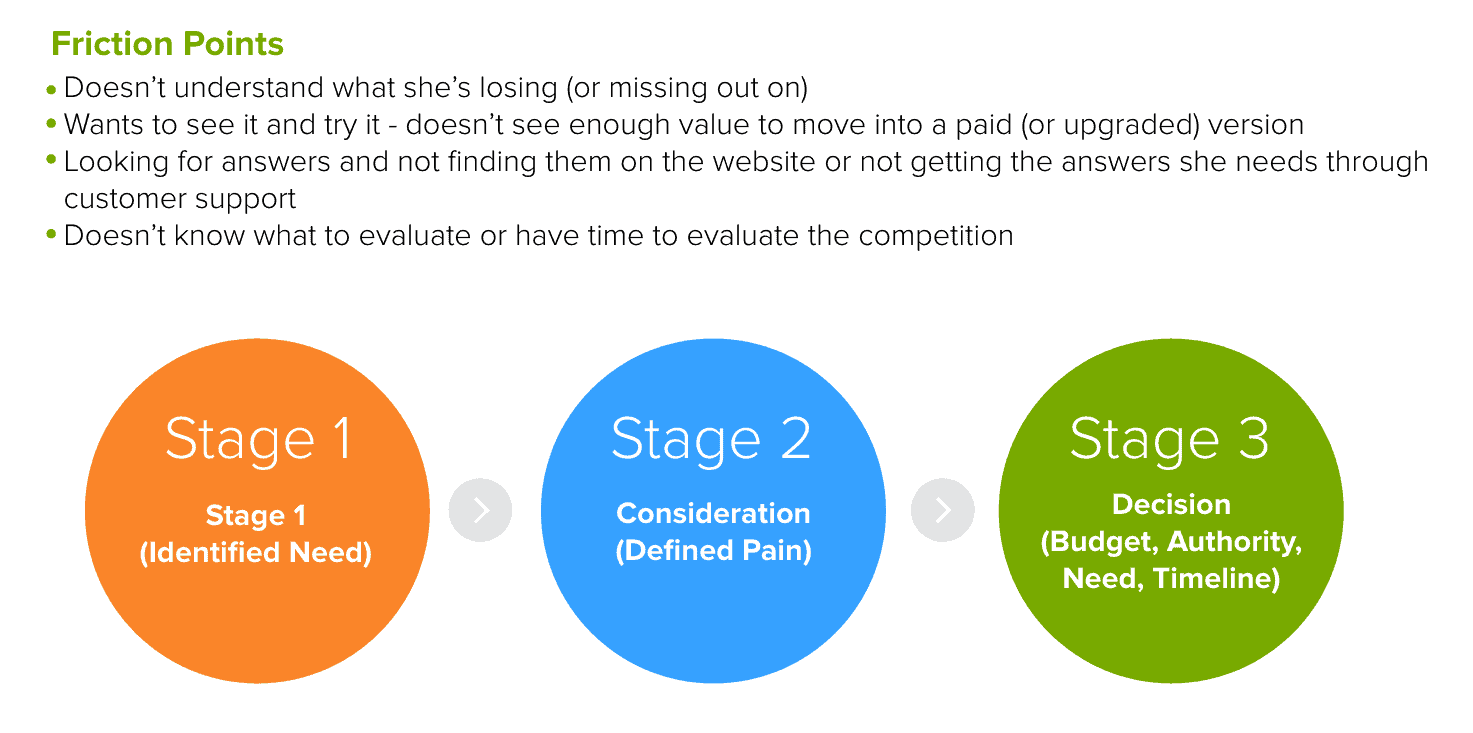
What’s pushing your audience towards the old (comfortable) decision and away from you? New equals change and that’s scary to almost everyone.
Here are some practical methods from Hubspot for gathering the information you need to develop personas:
- Look through your contacts database to uncover trends about how certain leads or customers find and consume your content.
- When creating forms to use on your website, use form fields that capture important persona information. For example, if all of your personas vary based on company size, ask each lead for information about company size on your forms.
- Take into consideration your sales team's feedback on the leads they're interacting with most. What generalizations can they make about the different types of customers you serve best?
- Interview customers and prospects, either in person or over the phone, to discover what they like about your product or service. This is one of the most important steps, so let's discuss it in greater detail ...
As you become aware of who the person is you’re speaking with (writing for), think about the benefits of working with you. What will they earn, be able to do better, how will it improve their life?
All of this will work its way into your social media content. Because remember, the more you focus on the benefits and value you offer, the more useful you and your company become.
3. Use emotionally charged copy
People don’t want to spend all day reading about your product or service. They want to be entertained, surprised, enlightened, and motivated. As Jonah Berger points out in his book “Contagious,”
“A product, service, story has to beckon emotion…the right emotions. [Because] When we care, we share.”
And sharing is the byproduct of highly useful content. But what exactly does emotionally charged content look like?
Take these two examples. As a Pittsburgh Steelers fan, the Mean Joe Green Coca-Cola commercial has always been one of my favorites. Who doesn’t smile from the emotional connection created between Mean Joe and that young kid?
And who doesn’t know the Budweiser commercials? This Clydesdale and puppy bonding moment is one of the Super Bowl’s best.
That emotion is exactly what you want to tap into. While you might not be the sappy or sensitive type, your audience could be.
Find what moves and motivates them, and then weave that into your social media content.
Here's how to use it:
Test the emotional value score (EMV) of your social media posts with the Advanced Marketing Institute Headline Analyzer.
I use this as an initial A/B test. How will this resonate with my audience on an intellectual, empathetic, and spiritual level?
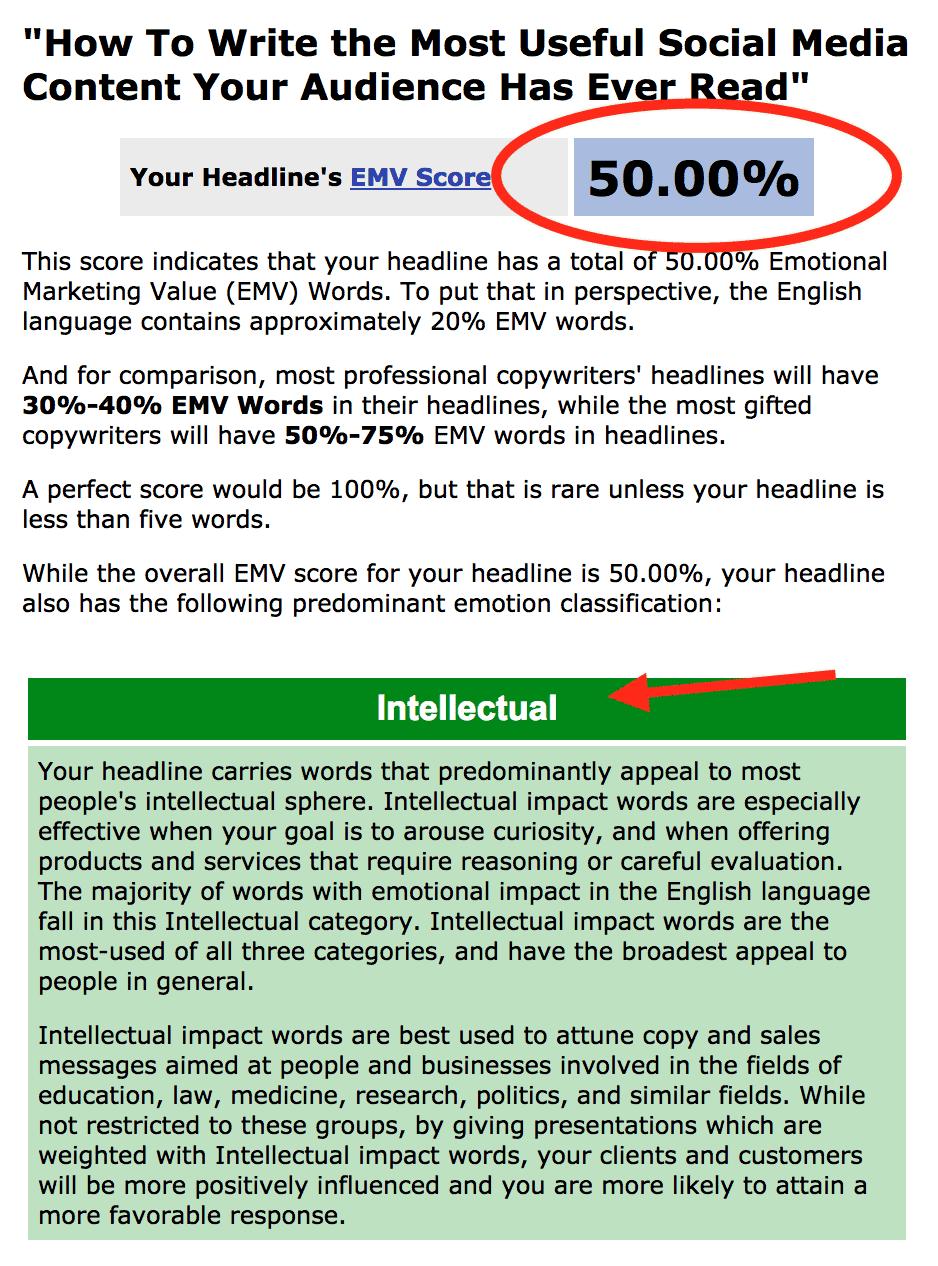
To use it in your content, start by taking a headline and write two different versions. Here’s an example using this blog post.
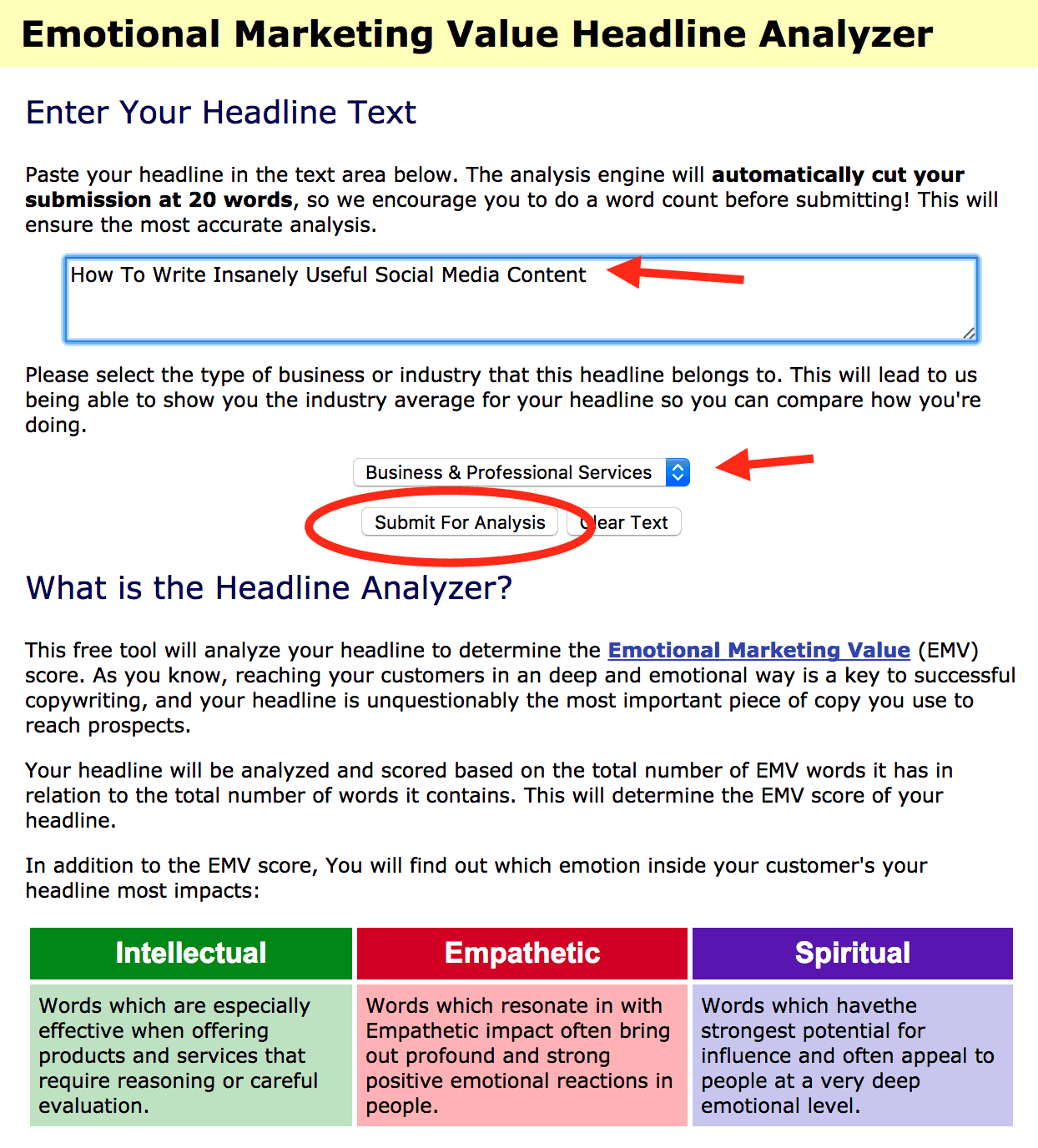
This iteration received a 50 on the EMV scale. I’ve been testing for years and have found that 50 - 70% is my sweet spot for highly shareable content.
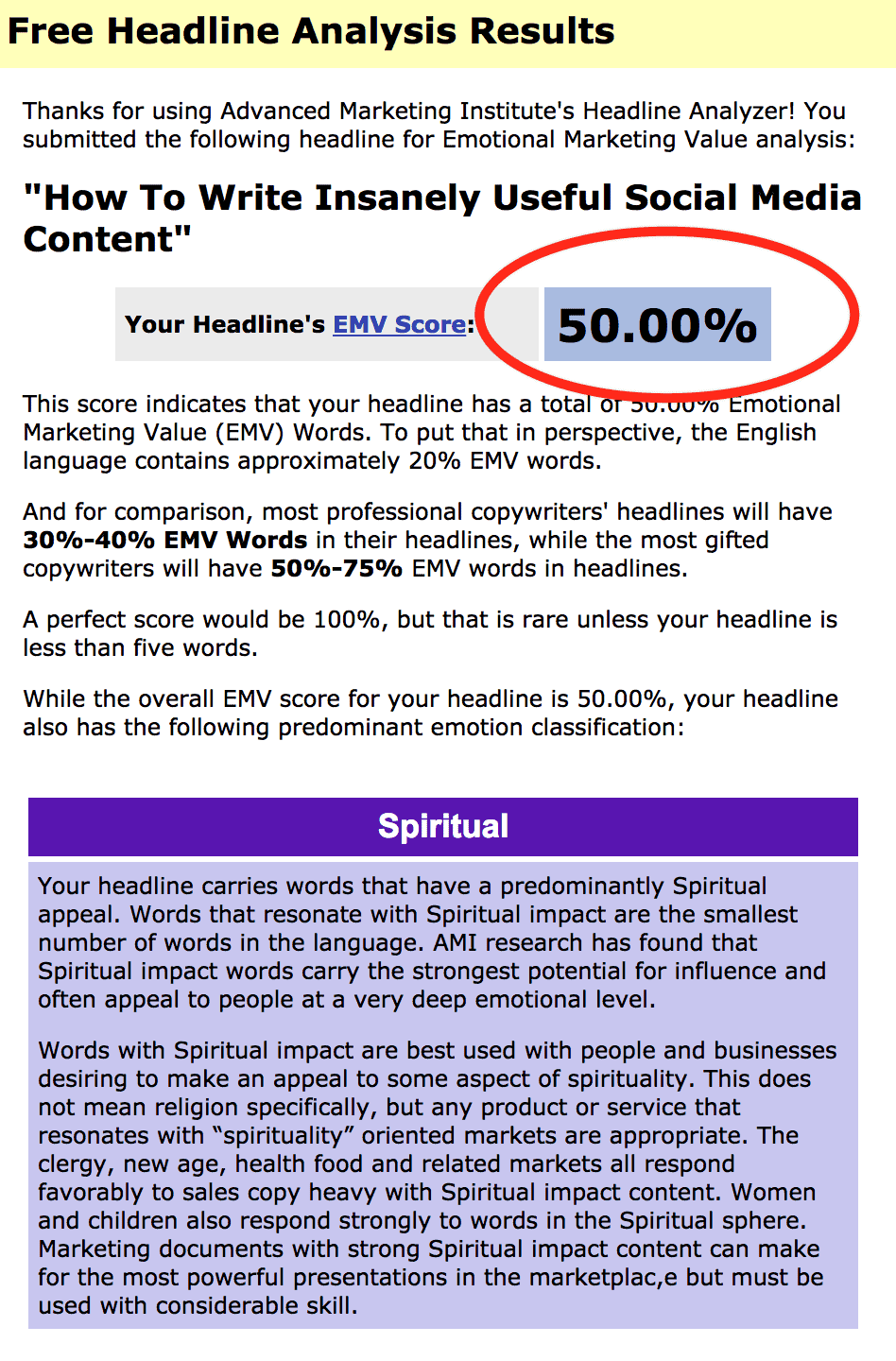
This one is well outside of my current champion. The 50-70% I mentioned above.

Dependent on your target market, speaking to an intellectual crowd as opposed to spiritual can make a huge difference in perceived value. Test the EMV of your copy, share across social media, and then determine your sweet spot by analyzing the outlier.
What was most successful and what variation was used? Now turn that into a template you can rinse and repeat over and over again.
4. Share captivating stories
Every business has a story. What’s yours? The key is to share it in a real and relatable way. Think about it. Who do you connect with online and in real life? It's the people and companies that move you. Let your story bring your audience into your world. By doing this, you're creating a bond, and that translates into trust over time.
Seth Godin defines a story like this,
“Great stories make a promise. They promise fun, safety or a shortcut. The promise needs to be bold and audacious. It’s either exceptional or it’s not worth listening to.”
If you’re lost on how to tell your story, there’s no better place to start than analyzing the great storytellers within your industry. How are they using social media to create points of interest and encourage deeper, more significant relationships? As Ian Rowden, Chief Marketing Officer at Virgin Group says,
“The best brands are built on great stories.“
And Virgin knows how to show and tell a great story. No matter where you look, the culture and personality of the Virgin brand are clear.

A post shared by Virgin (@virgin) on Apr 17, 2020 at 3:19am PDT
How to express your company story
- What details can you share that will allow customers to make an educated decision about your business?
- What would people love to know about how you built your company? What did you learn along the way?
- How can you communicate the essence of your business?
- Why do people hire you or your product? What are they looking to achieve through you?
- Share what you do, what problems you solve, and why you’re passionate about your product or service.
Enthusiasm is contagious. Make your idea worth catching!
5. Declare war on bland
The average person reads 6.5 hours per week. That means you’re spending close to 1 hour per day consuming content. While that doesn’t make you an instant copy expert, you do know the difference between unique and cookie-cutter. I'd also bet that in the midst of this reading, you've also become quite picky about what you give time to.
It shouldn't be a surprise that your audience feels the same way. If you want your social content to stand out, you need to declare war on bland and boring. Brands like Adobe and Volkswagen have done exactly that. They've set themselves apart by translating an established offline brand into a vibrant online culture.
Could someone emulate the brand? Of course, and they have. Can there be an exact duplicate? Not in my opinion. If you want to build a legion of fans, simply dropping links to your content isn't going to work.
How to set your company apart
Write down your answers and use them as positioning statements across social.
- What do you do better than anyone else?
- What do your customers love about your company?
- What proof do you have? (testimonials, awards, etc)
- What problems do you solve? (be specific)
- Who have you helped and what was the outcome?
- How do you improve your customers' lives?
- What's your company vision and why does it drive you?
- What does success look like to you, your customers, and within your industry?
- What's the cost of being ordinary and what are you doing every day to combat that?
Brainstorm those questions and write down as many answers as possible. You'll be amazed at how quickly they'll help you formulate a value proposition.Each one can be used across social to create differentiation and position you as the brand of choice.
6. Apply the rule of one
I’ve written about this many times in the past, but never in the context of social media. The idea behind the rule of one is simple: Know the goal of your post and stick with it. Don’t get lost in a sea of options. It's easy to get overeager about what you have to share. I get it. You love your business. But abstain from the idea that more is better. Instead, focus on one key takeaway in each of your posts.
Why? Because marketing is just like sales. A confused mind won’t buy. So when you add too many options, your audience gets confused. Do they call, click, share? Probably none of the above if you’ve made too many requests in one post. The bottom line: Know the end goal of each post and align it with your CTA.
7. Useful content is shareable content
The final and most important component is writing content people actually want to share. Getting likes and comments on Facebook may feel great, but it can't compare to the power of a share. Once one person shares your post, a whole new audience is opened up. Now you're in front of a group that you otherwise might never have reached. In essence, shares are your greatest form of word-of-mouth marketing.
To create useful, share-worthy content, you need 3 things:
1. Original content. As Herman Melville once said,
It is better to fail in originality than to succeed in imitation.
It's the same with social media marketing. If you want to stand out, you need to be unique. This doesn't mean every piece of content is original, but it all must align with your brand.Put your own voice into everything you share.
2. Irresistible content. Stella & Dot, a boutique-style accessories company, does this in every post. Their content is irresistible to their social fans - female entrepreneurs. They're not only selling the dream of financial freedom but a revolution against more of the same.
3. Empathetic content. Empathy. A word tossed around a lot these days but often misunderstood. Ann Handley, the author of "Everybody Writes," says empathy is,
The most important in marketing today is the idea of empathy. I would even go so far as to call it pathological empathy. You’ve really got to focus relentlessly on the recipient.
When your content is empathetic to the needs of your audience, you acknowledge that you understand their current situation. In other words, your social media content must humanize your brand.
Final thoughts
Not every one of your posts will be gold. But, if you take the time to:
- Research your audience
- Understand what they're looking for
- Discover how to deliver ridiculously valuable content consistently...
You'll find that producing social media content your audience wants to share becomes effortless. What content are you creating that your audience eats up? I'd love to hear it (and see it) in the comments below!
Updated: May 2020
About Rebekah Radice
Rebekah Radice, co-founder of BRIL.LA, has traded narcissism for purpose. When not driving growth, you'll find her tricking family into thinking she's Emeril Lagasse - likely covered in marinara. The spotlight was fun, but impact is better. These days she's using 20+ years of brand brilliance for good.
